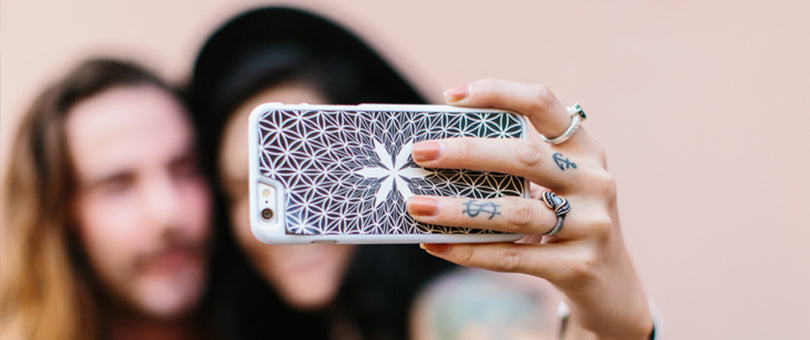Competition is the natural order in business, especially for ecommerce brands where it’s not just your local competitors that you need to worry about.
Customers are overwhelmed with options, and they want to quickly understand what makes one product or brand different than another. Knowing the right way to position yourself and your products can mean the difference between standing out and blending in.
That’s why it’s crucial for all entrepreneurs to understand how to identify a unique selling proposition (USP) to help guide your branding and marketing decisions.
What is a unique selling proposition?
A unique selling proposition, more commonly referred to as a USP, is the one thing that makes your business better than the competition. It’s a specific benefit that makes your business stand out when compared to other businesses in your market.
Forming an opinionated and deliberate USP helps focus your marketing strategy and influences messaging, branding, copywriting, and other marketing decisions. At its core, a USP should quickly answer a potential customer’s most immediate question when they encounter your brand:
“What makes you different from the competition?”
Your USP plays to your strengths and should be based on what makes your brand or product uniquely valuable to your customers. Being “unique” is rarely a strong USP in itself. You have to differentiate around some aspect your target audience cares about, otherwise your messaging won’t be nearly as effective.
A compelling USP should be:
- Assertive, but defensible: A specific position that forces you to make a case against competing products is more memorable than a generic stance, like “we sell high-quality products.”
- Focused on what your customers value: “Unique” won’t count for much if it’s not something your target customers truly care about.
- More than a slogan: While a slogan is one way your USP can be communicated, it’s also something that you can embody in other areas of your business, from your return policy to your supply chain. You should be able to talk the talk and walk the walk.
It’s not necessarily what you sell that has to be unique, but the message you choose to focus on that your competition doesn't.
What a unique selling proposition isn't
Specific marketing offers—like 10% off, free shipping, 24/7 customer service, or a strong return policy—are not USPs. Convincing and effective though they may be, they’re not unique on their own, nor are they positions that are easy to defend as any of your competitors can copy them.
A unique selling proposition is a statement you choose to embody that differentiates your products and your brand from your competitors.
A USP is also not just the header copy on your homepage. It’s a position your small business takes as a whole that can be incorporated into your products, your brand, the experience you provide, and any other touch point your customers have with your business.
The best way to understand what makes a powerful USP is through examples. So here are ten examples of unique selling propositions that get it right and what you can learn from each.
10 examples of unique selling propositions done right
1. Saddleback Leather
One of the first things that you notice about Saddleback Leather’s site is their famous tagline: “They’ll fight over it when you’re dead.”

It’s a sentence that immediately conveys the unique value of Saddleback’s products in their signature irreverent tone: this product is built so well it will outlive its owner. The messaging also refers directly to their 100-year warranty, which backs the promise with a guarantee that the products will last you a lifetime and then some.
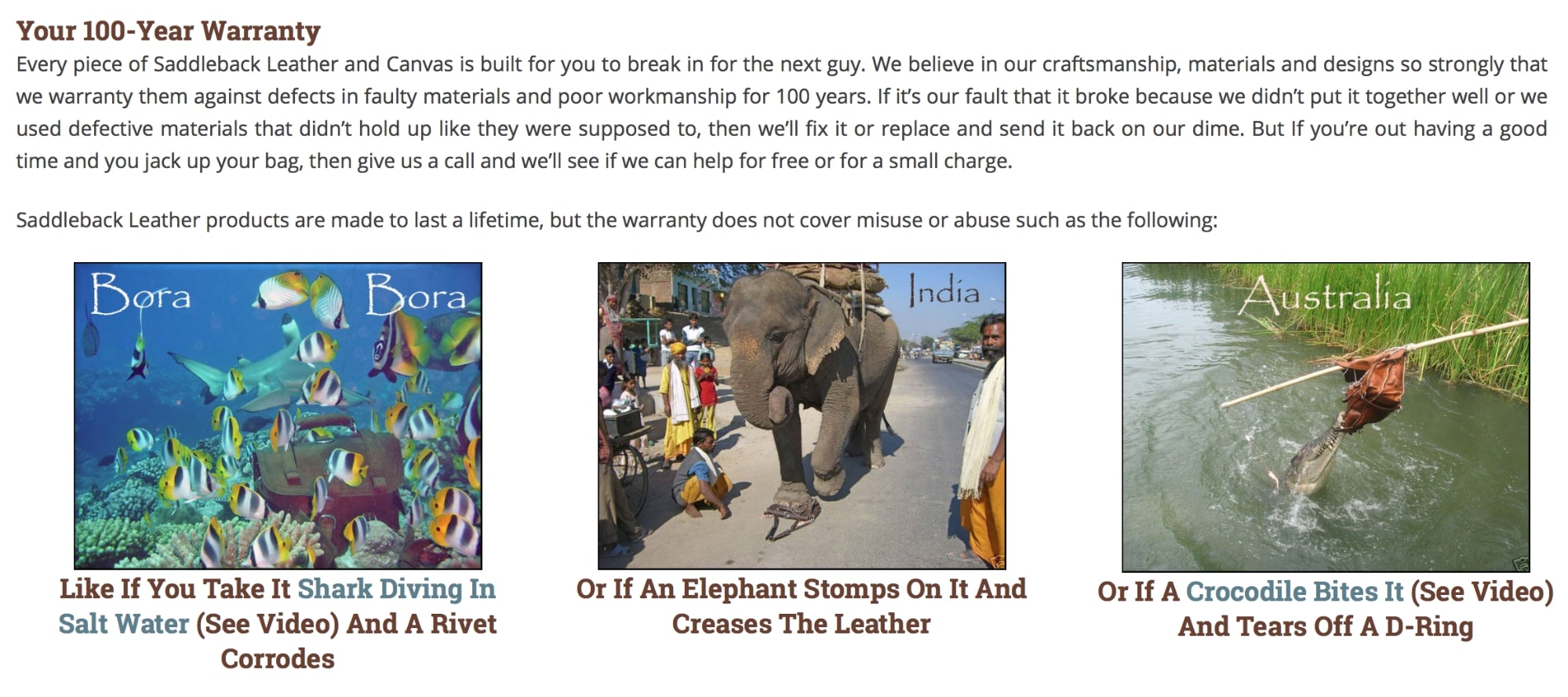
Longevity, especially for high-priced, everyday carry products is definitely a unique selling point, especially when so many competitors are focused on positioning their products as status symbols, the stylish trends that you’ll want to replace next year, or a cheap solution to an expensive look.
In fact, when cheap knockoffs of their products started appearing in the market, Saddleback Leather took it as an opportunity to create a clever “how it’s made” video that reinforces the quality of their own craftsmanship.
2. Pipcorn
You can buy pre-popped popcorn at your local dollar store, so “mini-popcorn” on its own isn’t much of a USP.
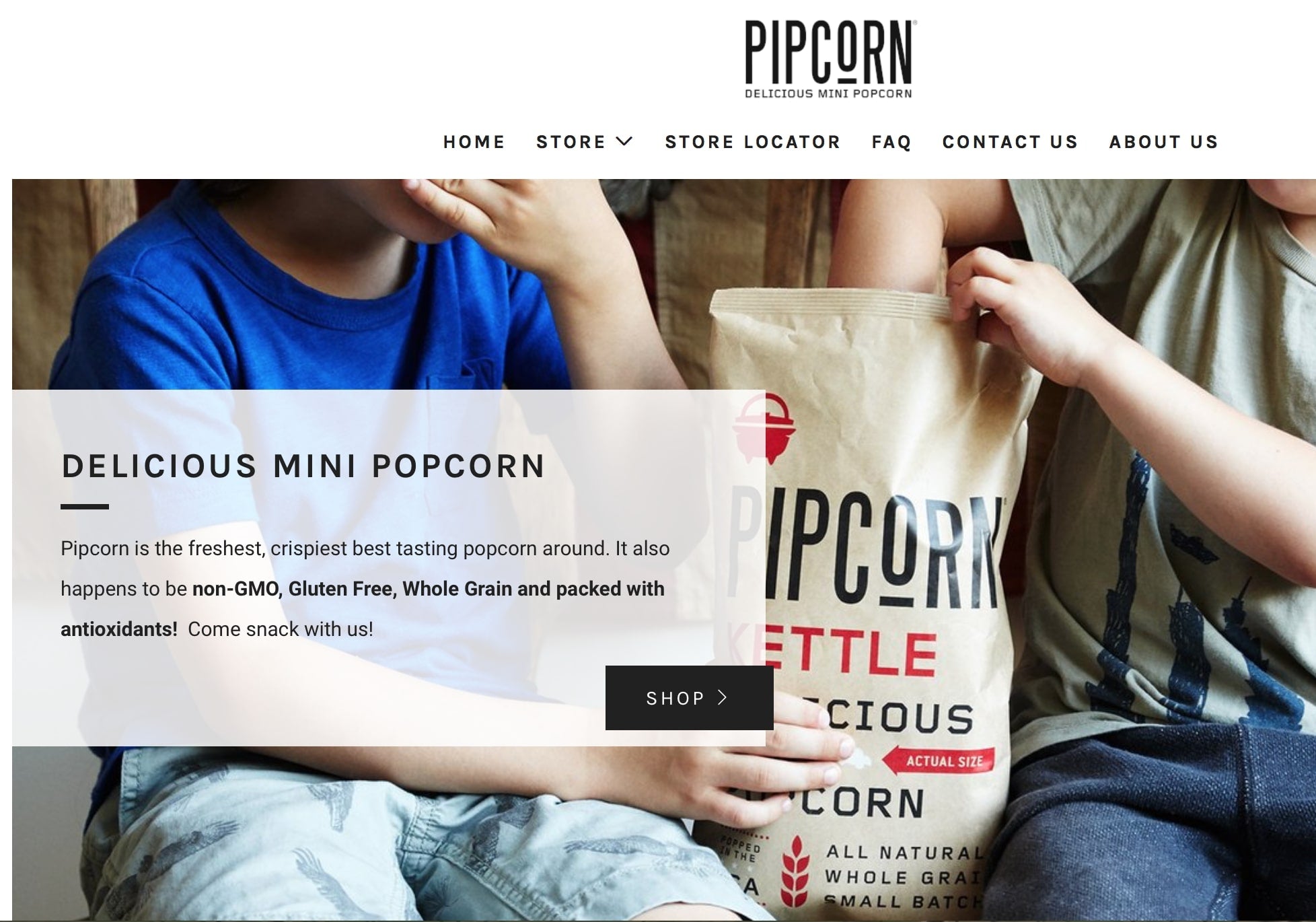
Instead, Pipcorn is a great case of a brand using specificity to carve out their own unique place in the market, choosing instead to focus on what makes their product a smart choice for the health-conscious or vegan consumer.
Phrases like “all natural,” “whole grain,” and “small batches” are seen on the bag, and their site highlights other health benefits like gluten free, non-GMO, and antioxidants. Pipcorn also gets specific about how their snack food is healthy instead of just saying that it is, listing points of difference that their customers will care about.
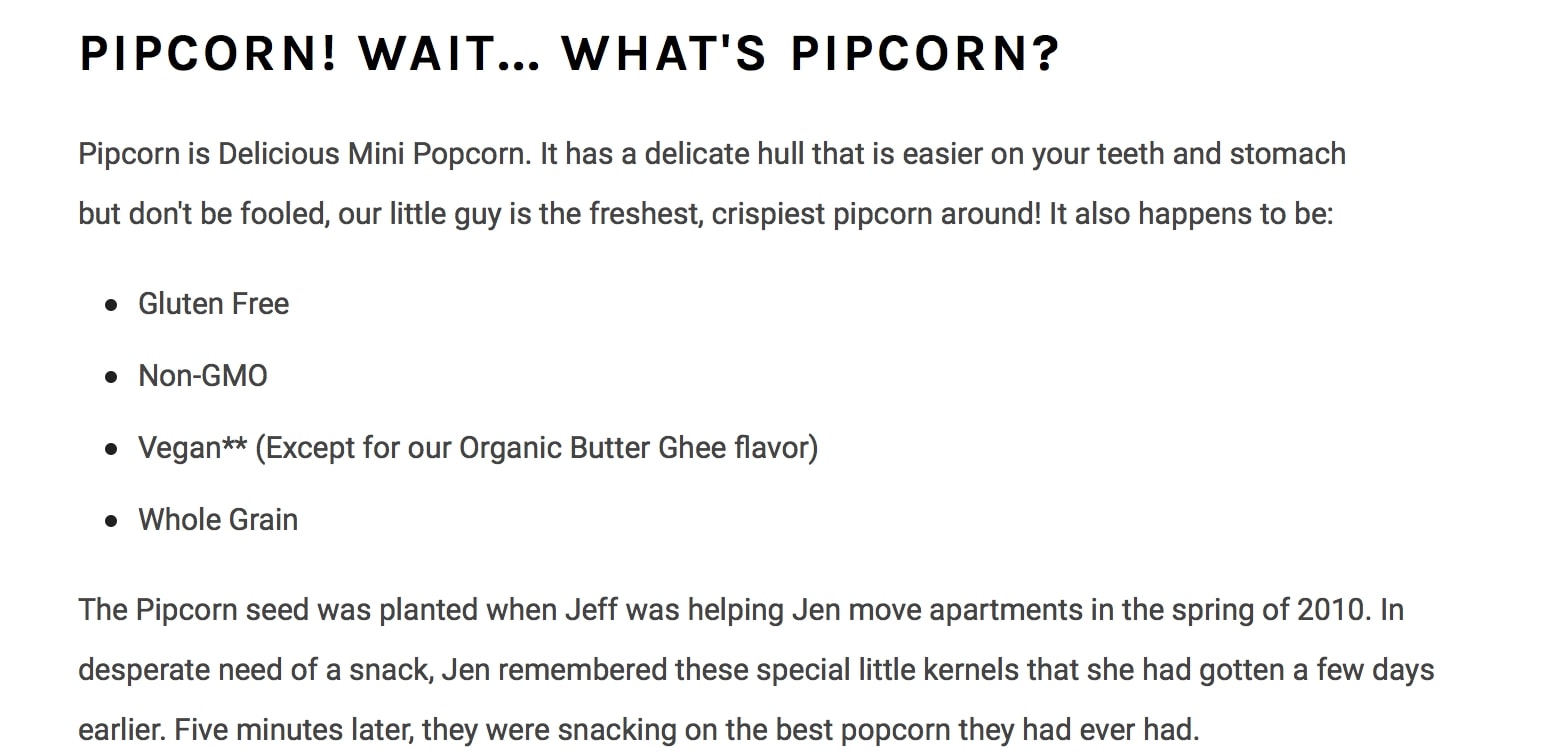
By positioning their product around current health-conscious trends, they're able to create a USP that would not only actively help them attract new customers, but also retail their popcorn as a premium product.
3. Death Wish Coffee
A lot of coffee shops and roasters lay claim to having the “smoothest” or “richest” cup of coffee out there. Death Wish Coffee, however, chose to cater to those who need an extra kick in their cup of joe by instead selling the “world’s strongest coffee”.
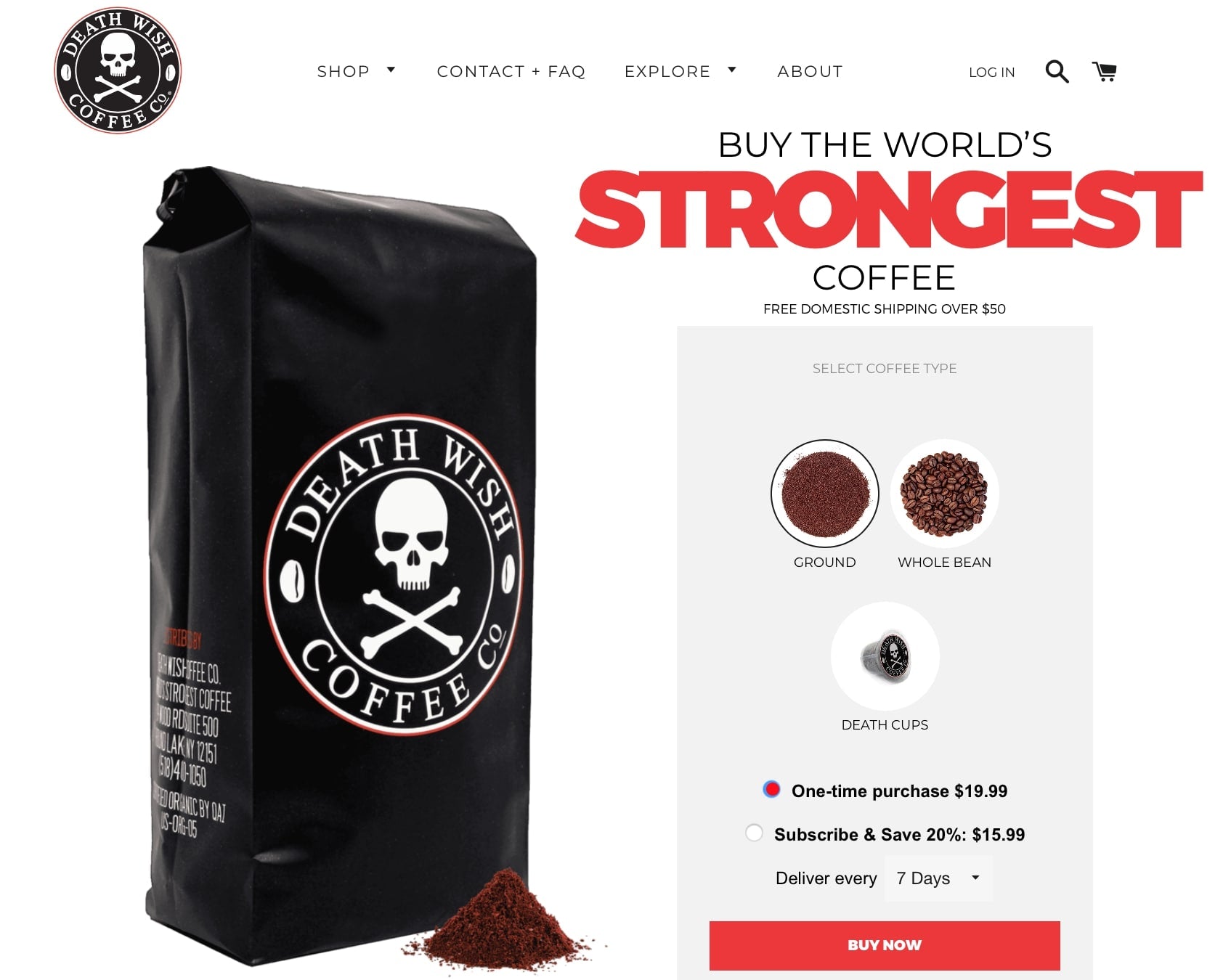
Death Wish Coffee is an excellent example of developing a product based on a unique selling proposition that was largely left untouched in the crowded coffee market. It’s not a position that will immediately attract every kind of coffee drinker, but the product firmly appeals to a certain segment of consumers and it’s hard to imitate.
Death Wish Coffee backs it up too. In addition to boldly declaring it on their site and packaging, and breaking down how it’s made, they also offer full refunds for anyone who says that the coffee wasn’t the boldest cup they’d ever had.
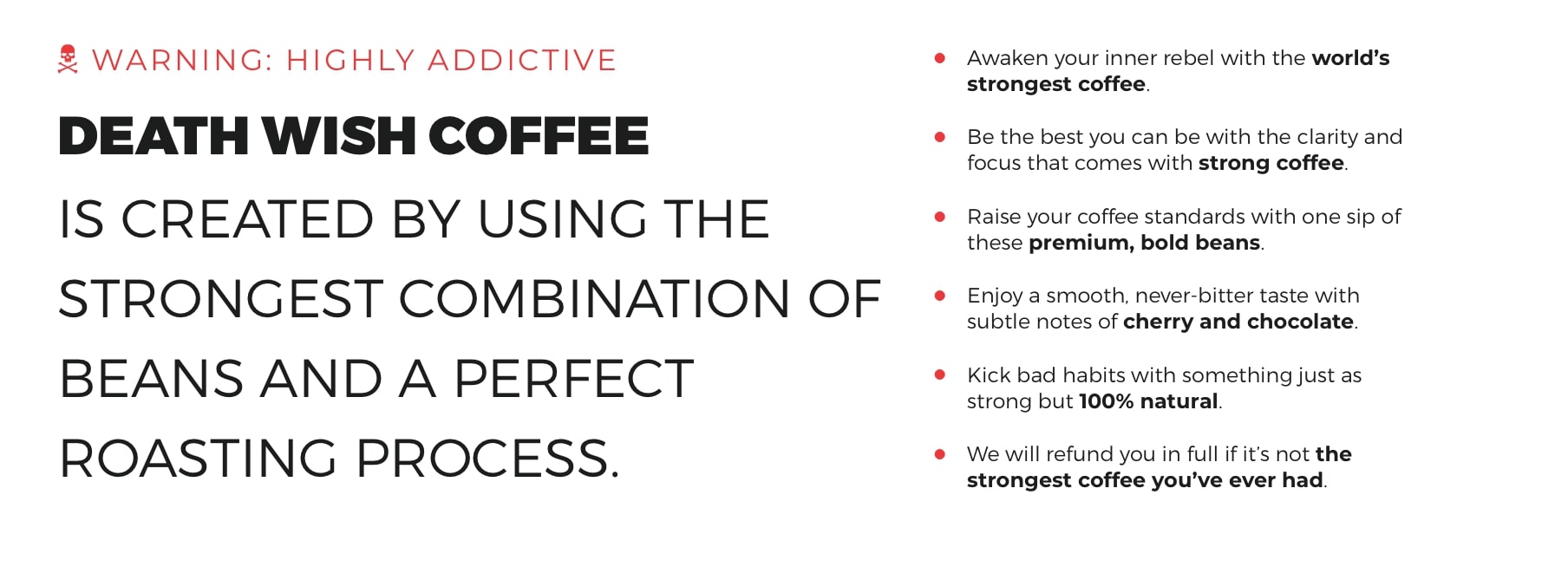
4. Muse
Muse is a noteworthy example of why you need a USP even when your products are truly unique. Muse is the first consumer tool out there that can provide real-time feedback about your brain’s activity as you meditate.
They are the first company to offer what they do, but having no direct competitors doesn’t mean they don’t have any competition at all. People have been doing just fine for centuries without their product, after all.
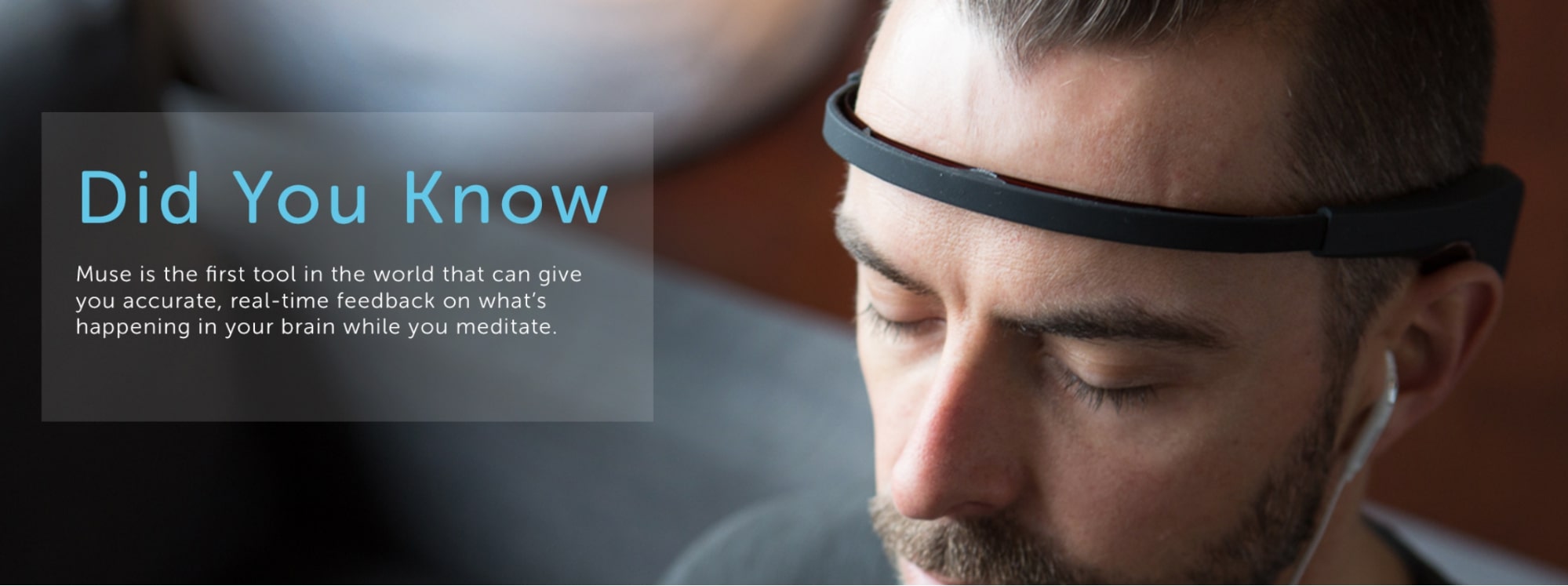
In this case, Muse’s biggest competitor is the status quo: unaided meditation. So their USP, naturally, is around enhancing your existing practice to “get the most out of meditation.”
You can see how a lot of their copy, while focusing on different selling points, comes together under this single idea.
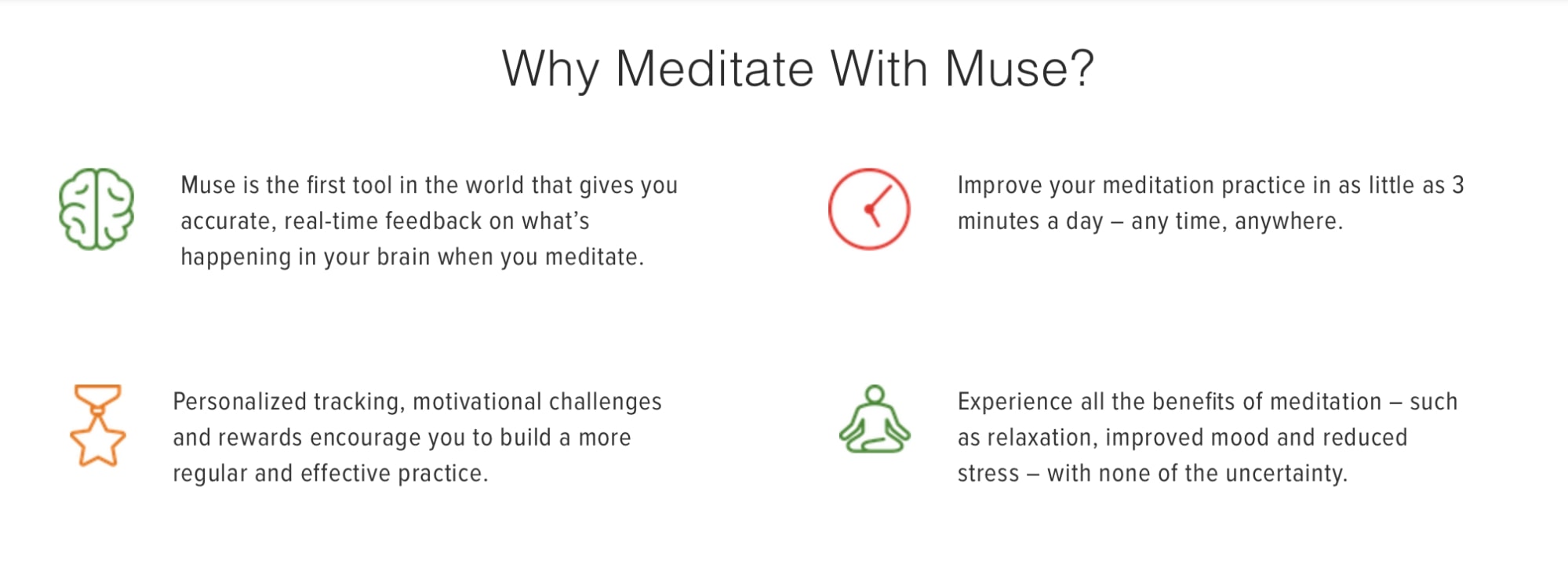
Throughout their content and their marketing messages, they build a case for both mediation in general and for meditation aided by their product. This is a smart example of acknowledging the norm to position yourself as a truly different solution.
5. Taylor Stitch
Taylor Stitch is a clothing company that relies on crowdfunding in order to develop new products. While some consumers may frown upon established brands that leverage crowdfunding, that isn’t the case here because of how they make it a part of their USP.
Taylor Stitch successfully turns crowdfunding into a competitive edge: “We design new products. You crowd fund them.”

They immediately let customers know why crowdfunding new products offers advantages to traditional self-funded or investor-funded business models. Customers are assured that:
- They’ll save 20% by preordering.
- It’s better for the environment.
- They get these products in your hands when you’d actually use them.
These are staples of crowdfunding that have been brought to the surface and translated into value for the customer—it’s hard to argue with saving money and being more environmentally friendly, and supporting a business you believe in is a nice bonus, too.
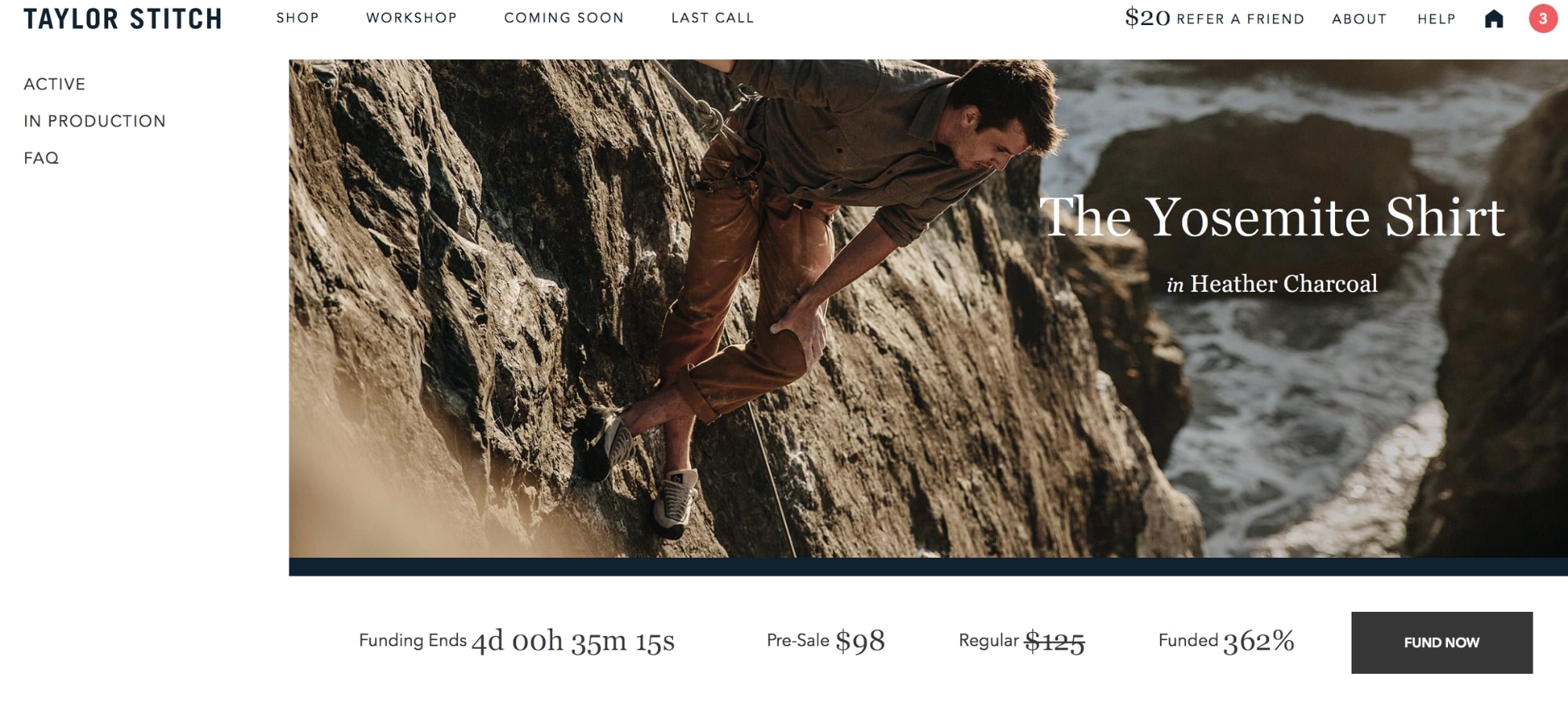
By positioning their unconventional business model this way, they turn a potentially risky pre-order process into a compelling marketing angle.
6. Tattly Tattoos
Many temporary tattoo products are intended for kids and feature simple and silly designs. Tattly Tattoos takes a different approach, offering gorgeous, intricate art for people of all ages.

These temporary tattoos are meant to be beautiful like traditional tattoos, allowing customers to express themselves without the commitment or high cost of real tattoos.
Tattly doesn’t have many direct competitors that sell similarly bold designs made from safe materials. This makes it easier for them to develop their USP, in theory, but they still need to differentiate themselves from the inevitable comparisons between their products and their more familiar counterparts.
By focusing on the art, they’re able to do that with their USP, which they express as: Fake tattoos by real artists.
Many design-centric brands source designs from real artists, but Tattly surfaces this fact about their business. The artists behind their designs are as much a part of what they sell as the tattoos themselves, getting prominent profiles on their site organized under a section dedicated to Artists and their works.
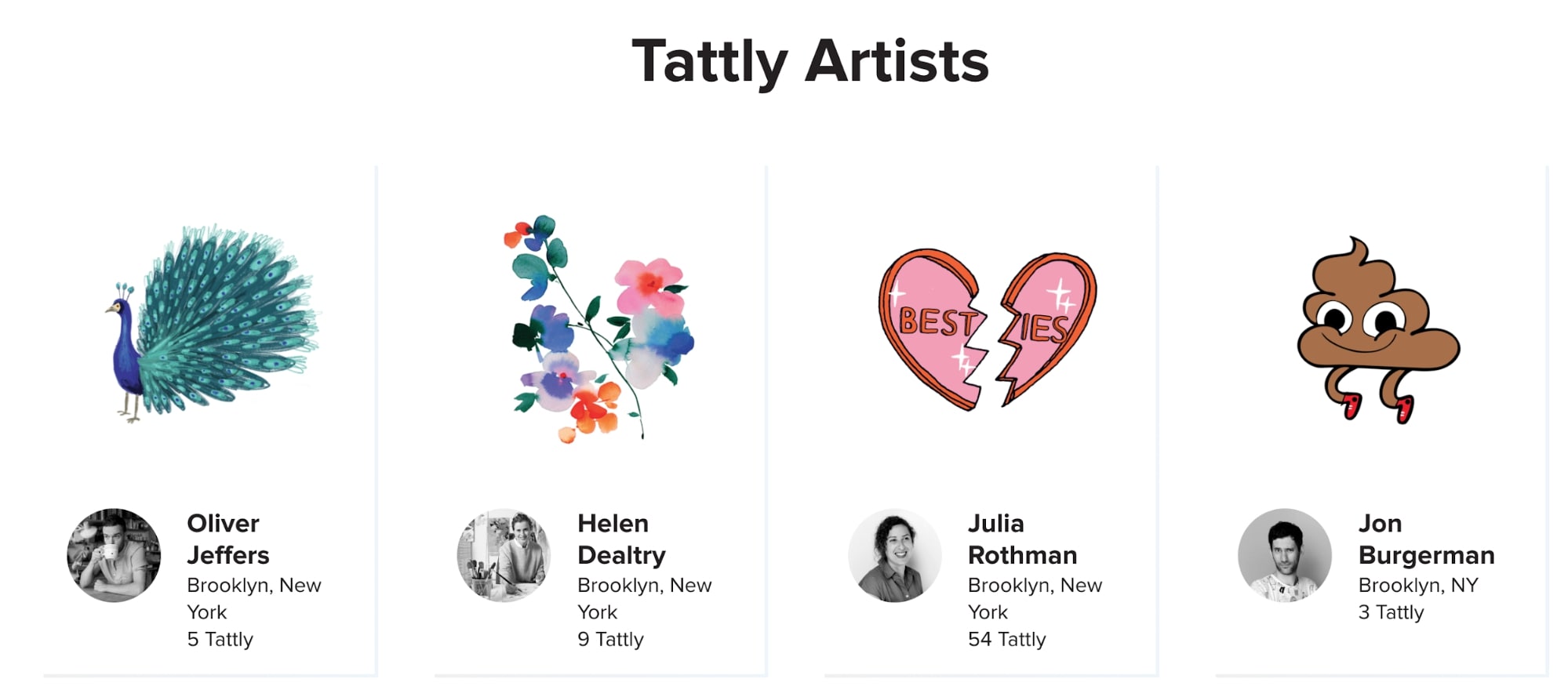
They could have left it as a mere line of copy on their site, but instead they chose to incorporate the artists behind their products into the design of their online store, reinforcing the idea that tattoos are a form of wearable art.
7. Third Love
Women’s lingerie is a billion dollar industry, so newcomer Third Love had to find a way to make sure they were able to compete with the legacy brands.
ThirdLove has made their “we have the right fit” USP an integral part of their branding. It’s not just a key part of the messaging in their ads and the copy on their site—they even have a Fit Finder quiz that allows first-time customers to find the right fit for them.
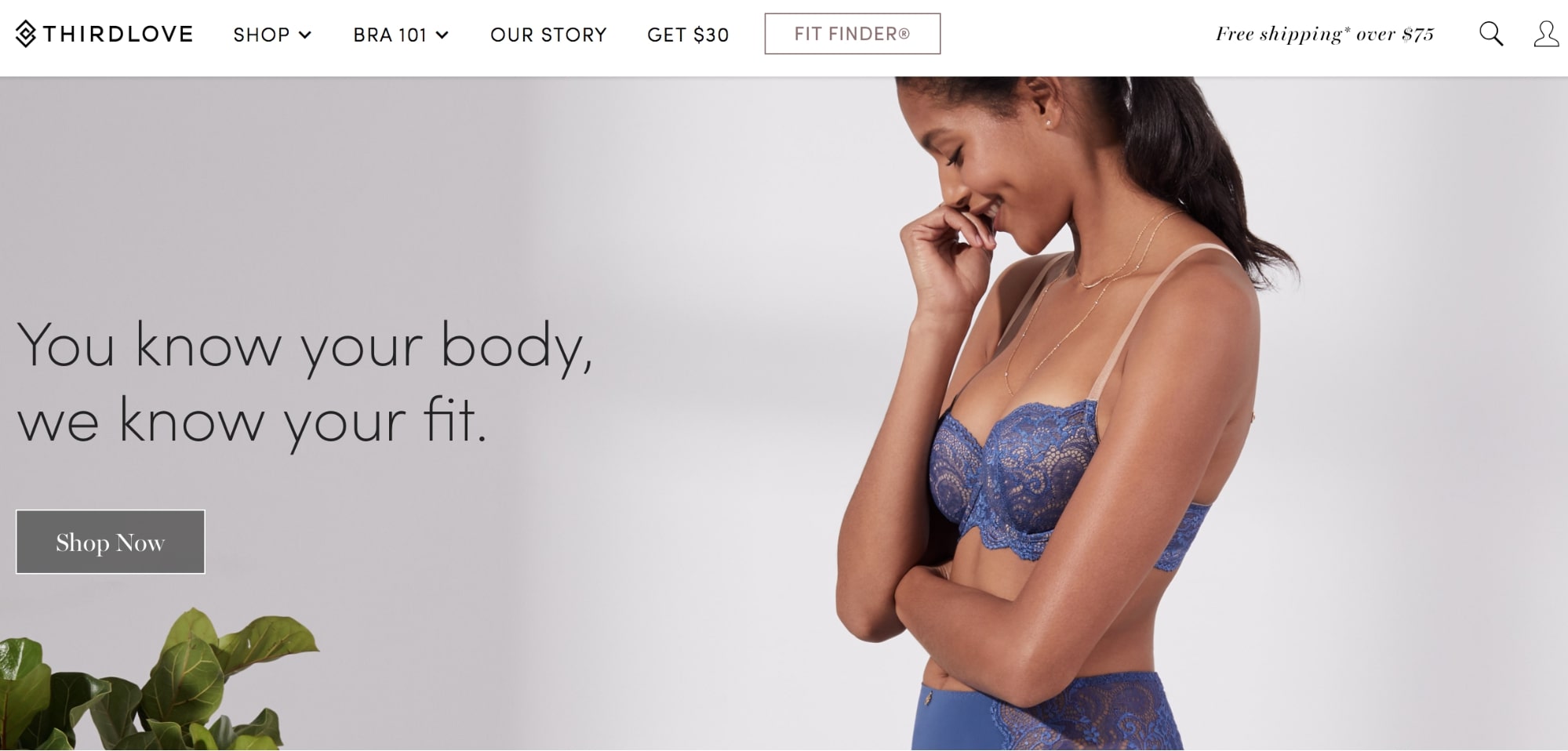
To go even deeper on their promise, they also offer half-sizes and a “try before you buy” guarantee.
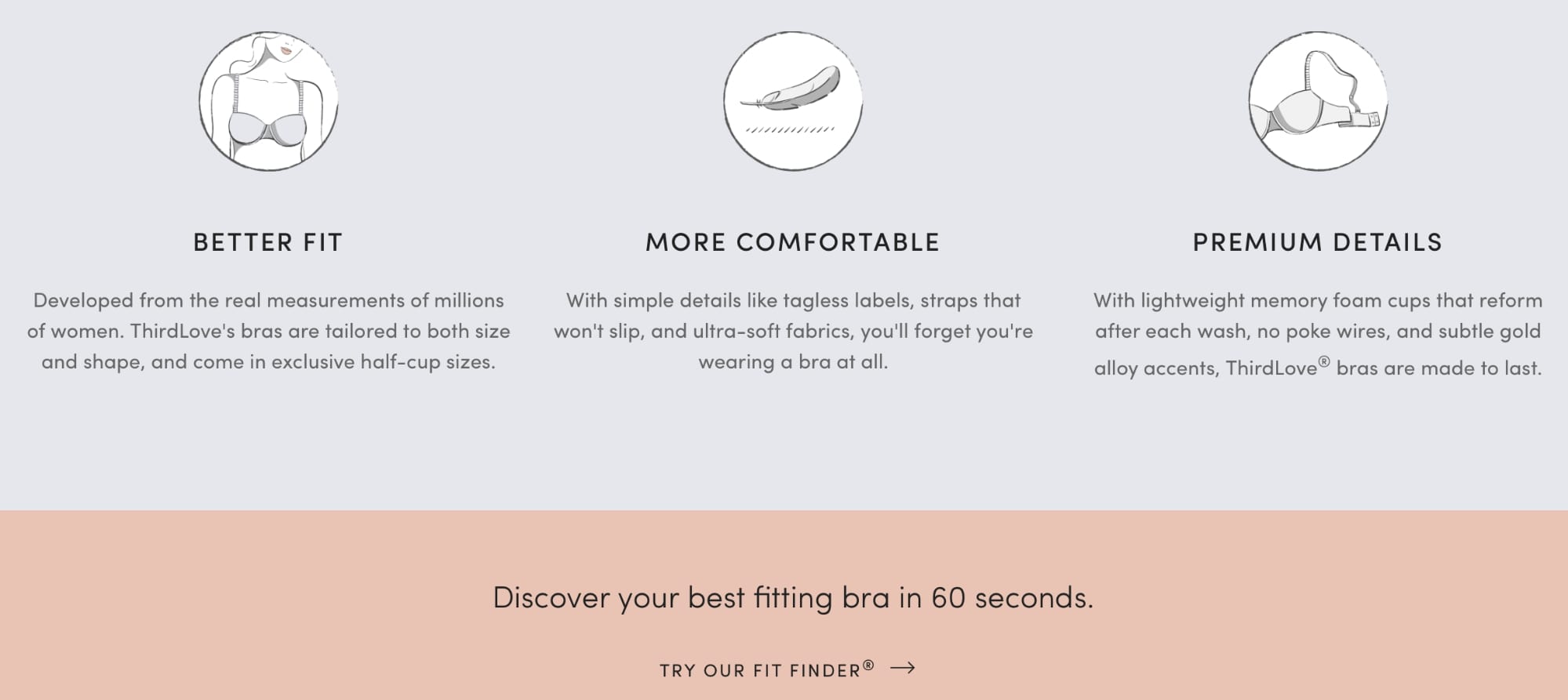
Third Love’s USP is a powerful promise. And while other brands might offer a sizing chart to help shoppers, Third Love prioritizes getting you the the right fit based on your individual needs.
Of all the messages they could have focused on, around style or quality, they honed in on a pain point that many women experience when shopping for bras, and they chose to double down.
8. Beardbrand
A lot of cosmetics companies—for both men and women—try to offer quick fixes at cheap prices, addressing symptoms instead of the root cause. Beardbrand’s USP takes the form of a product ethos that immediately sets them apart from the industry standard.
They want to create products that “work with your body’s natural chemistry, rather than to disguise or change it.”

They let users know that they don’t have harsh, drying, artificial products and instead use natural oils that work with the customer’s body chemistry.
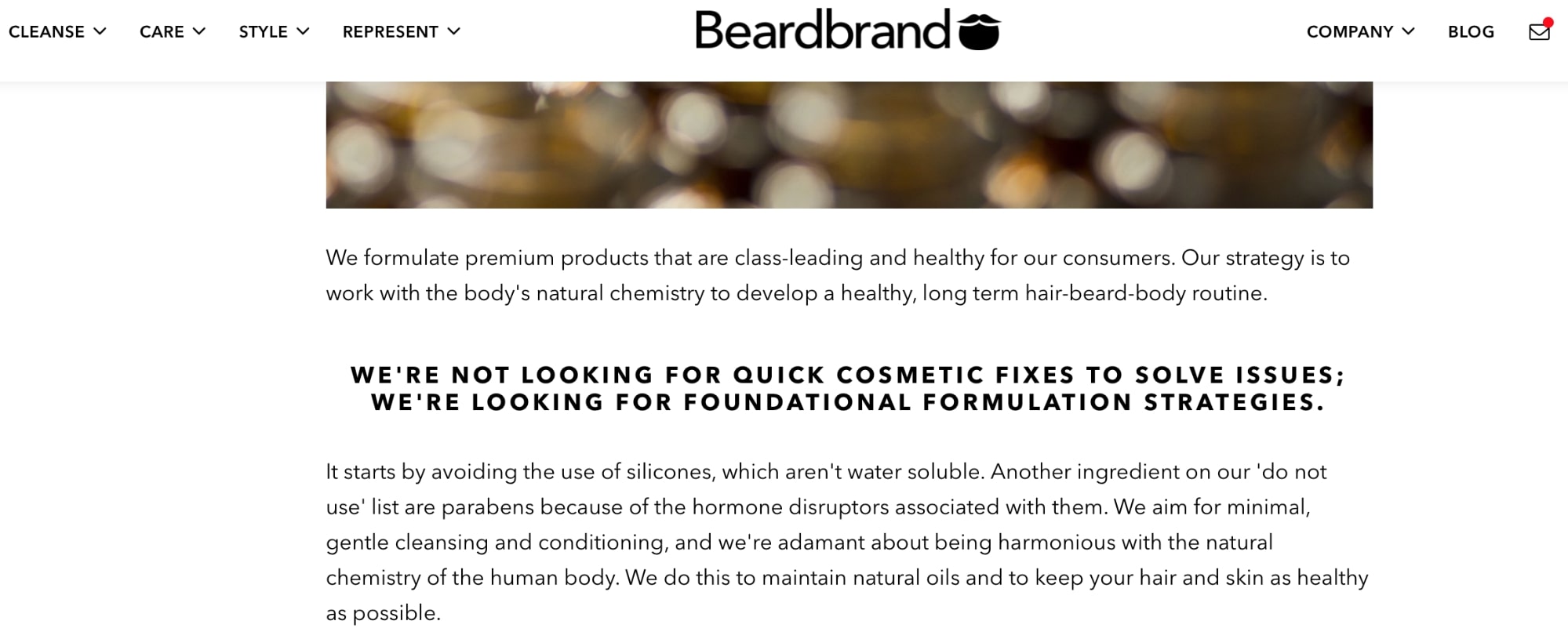
This product ethos means that they only sell products that live up to this standard and pit themselves against a rampant problem in their industry.
Casting the industry norm as an antagonist is a positioning strategy often used by brands that are confident about their solution to the customer's problems.
10. Twelve Saturdays
College students can get school spirit attire pretty much anywhere. They have local options right on campus, and most big-box stores even carry local college gear. So how does Twelve Saturdays compete?
Instead of just highlighting that they have college apparel, they remind students that there are twelve Saturdays in a football season and their products can help you look good for each one. Football games are big social events for college students, and many want to show up with a fresh look week after week. They don’t want to wear the same outfit multiple times, or arrive in the same attire as someone else.
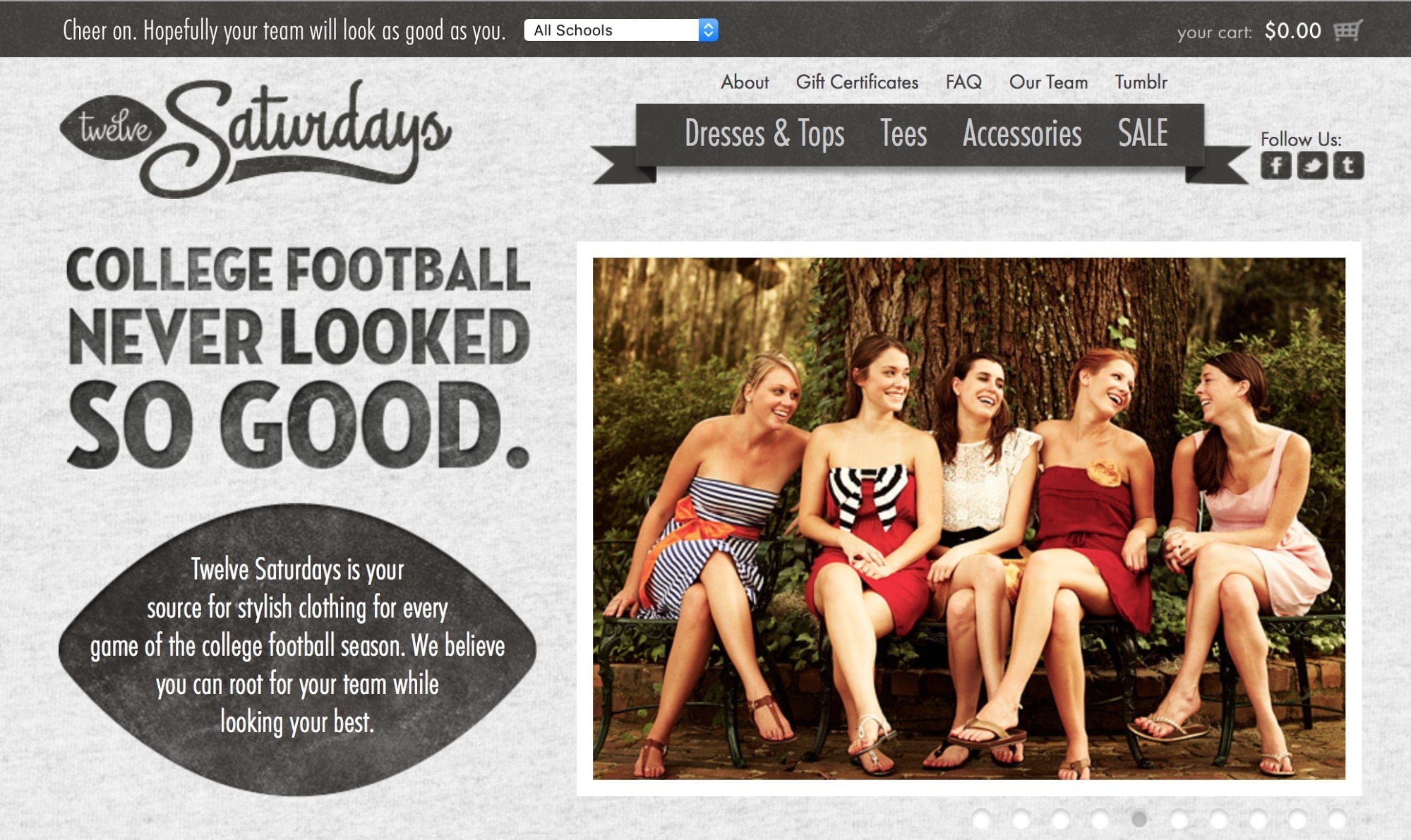
Twelve Saturdays bet on the idea of offering students fashionable, school spirit attire that guarantees they look good and feel good all season. They even own the fact that their products aren’t plastered with mascots and logos, focusing on style instead, which allows them to carry fewer products and target more schools.
“Looking good” may not sound unique as far as apparel is concerned. In fact, it probably seems obvious. But pairing it with a cultural phenomenon for a specific audience’s needs makes it fresh, compelling, and different.
This is a good reminder that a USP shouldn’t be a half-measure, but a whole-hearted effort to define your brand to your customers.
How to write your own unique selling proposition
Now that we’ve looked at ten examples of strong USPs from other businesses, you might be wondering how you can go about creating, uncovering, or refining your own unique selling proposition.
Every USP is going to be, well, unique but that doesn’t mean there isn’t a process you can follow to put yourself on the right track. Here's how you can write yours:
- Make a list of all the potential differentiators of your brand and what you sell. And get specific. Breakout products and compelling marketing messages rely on precision: they solve the exact right problem and communicate that benefit to customers in their own words.
- Research the competition. Who are your competitors and what are their USPs? Look for gaps where you can potentially introduce your brand differently. Products in the same category can be positioned in wildly different ways—footwear, for example, can emphasize style, comfort, or durability.
- Compare your most unique angles against your audience's needs. Are there any customer needs that haven’t been filled? Do you see any pain points that you can appeal to that your competitors haven’t?
- Compile the data. Take the information that you’ve learned, and sift through it to single out your strongest USP.
- Think about viable ways to apply it across your business. Applied properly, a USP can be woven into different areas of your business, from your brand name to your return policy to reinforce the idea to your customers.
Once you have a vague idea of what your USP is, it might help to express it as a positioning statement so you can get it down on paper:
[YOUR BRAND] offers [PRODUCT/SERVICE] for [TARGET MARKET] to [VALUE PROPOSITION].
Unlike [THE ALTERNATIVE], we [KEY DIFFERENTIATOR].
This won’t be exactly what you advertise on your website, but it should help you clarify your USP, its audience, and any specific differentiators that might be worth highlighting.
Unique selling propositions: Defining your competitive edge
A USP isn’t just a persuasive line of copy on your home page. It’s ultimately how you position your products or even your entire business to the rest of the world.
Your products don’t need to be wholly unique in and of themselves for you to have a strong unique selling proposition. Instead, look for a spot in the market where you can plant your flag that is relatively untouched by the competition.
There may be a dozen ways you could sell your products, but your USP is the big idea that best positions your brand according to what your customers care about and what your competitors aren’t.
Read more
- What Is Shopify and How Does It Work? (2023)
- From Clicks to Customers- 16 Online Business Ideas You Can Start on the Side
- Alibaba 101- How to Safely Source Products from the World's Biggest Supplier Directory
- How to Develop a New Product (From Concept to Market)
- Motivational Quotes- 100 Inspiring Quotes to Start Your Day
- Best Hashtags for Instagram- How to Find the Most Popular Hashtags and Connect with New Followers
- Shoot Reflective Products Like a Pro With These DIY Lighting Setups
- The Complete Guide to Ecommerce Product Photography
- Selling Through Storytelling- How to Craft a Compelling Brand Story
- Customizing Your Shopify Theme- How to Use Images, Colors, and Fonts




